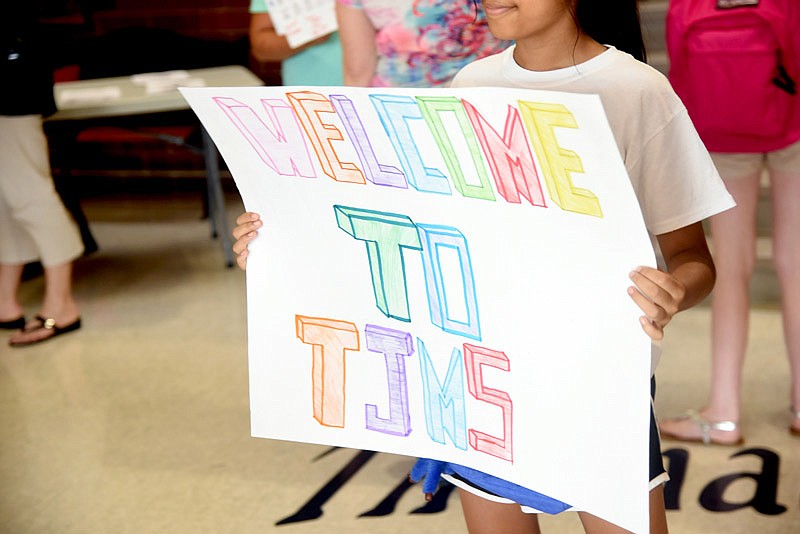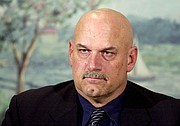Whether a "haves and have-nots" situation would develop between the two high schools in Jefferson City Public Schools' proposed plan has been one of the main questions raised about the April 4 ballot issues.
Proponents have pointed to JCPS' two middle schools on opposite sides of the city as indicators a gulf between students would not develop between two similarly located high schools.
"I find it hard to find where there's (evidence) for the current middle schools, and how you can say based on any measure or any statistic that they are disparate or there's a significant difference in those two populations," Ken Enloe said during the News Tribune's school issues forum March 7.
Enloe is co-chairman of the community outreach committee Citizens Investing in J Plus C, a group of private citizens campaigning in support of the two-high school plan ballot issues.
One of the mail fliers recently sent out by Citizens Investing in J Plus C states, of Lewis and Clark Middle School's 931 students, 63 percent receive free or reduced-price meals, and there is 32.1 percent ethnic diversity.
The same flier states, of Thomas Jefferson Middle School's 1,021 students, 58 percent receive free or reduced-price meals, and there is 38 percent ethnic diversity.
"There's actually more diversity this year at Thomas Jefferson than there is at Lewis and Clark," JCPS Superintendent Larry Linthacum said at the March 7 forum.
Data from the Missouri Department of Elementary and Secondary Education (DESE) can be used to make comparisons between the two middle schools - Lewis and Clark on the east side and Thomas Jefferson on the west side - and track changes over time: the percentage of students at each school who receive free or reduced-price lunches, a breakdown of the schools' racial and ethnic diversity, and students' standardized test scores.
Those numbers may not necessarily portray the environments at individual elementary schools within each middle school's boundary lines, but they paint broader pictures of each side of Jefferson City.
Students on the east side or across the Missouri River from Callaway Hills, Cedar Hill, East, Moreau Heights, Thorpe Gordon (south of Stadium Drive) and North elementary schools attend Lewis and Clark. Students on the west side from Belair, South, Lawson, Pioneer Trail, Thorpe Gordon (north of Stadium Drive) and West elementary schools attend Thomas Jefferson.
In the district's proposed two high school plan, Thomas Jefferson graduates would attend the newly constructed high school off Missouri 179; graduates from Lewis and Clark would attend the renovated high school at 609 Union St.
Linthacum told the News Tribune he anticipates more tweaking of boundary lines across the district akin to changes made to the boundaries of East, Thorpe Gordon and Moreau Heights elementary schools last month. If or when those changes are proposed, the district will be proactive and communicate them, he said.
Income comparison
The number of students at either middle school who receive free or reduced-price lunch has increased more or less incrementally since the 2000-01 school year - as far back as DESE's available public records track. The middle schools have been open for students since the 1993-94 school year.
At the dawn of the new millennium, the eastern side of Jefferson City appears to have had a higher percentage of people in the community living with poverty; at a peak in the 2001-02 school year, Lewis and Clark's percentage of students who received free or reduced-price lunch was almost 7 percent higher than Thomas Jefferson on the west side.
Free or reduced-price lunch is a measurement of economic need among students: a higher percentage of students whose families can afford only subsidized meals for them to eat enough to make it through the school day reflects a higher level of poverty in their community.
The disparity between east and west has changed markedly since the early 2000s. After the 6.9 percent peak in 2001-02, the gap between Lewis and Clark and Thomas Jefferson in percentage of students who receive subsidized meals has generally shrunk - to the point where in some years Thomas Jefferson has had a slightly higher percentage.
For the past four school years, both middle schools have been within 1 percent of each other. DESE reports last year the schools were about equal, at 54.1 percent for Lewis and Clark and 54.4 percent for Thomas Jefferson.
Ethnicity comparison
Thomas Jefferson continues to have a higher percentage of students who are black, Asian or Hispanic than Lewis and Clark.
The percentage of students who are black at Thomas Jefferson has generally been between about 2-5 percent higher than at Lewis and Clark in any given school year since 2000-01. Both middle schools have tended to have similar percentages of students who are multi-racial; although last year, Lewis and Clark had 7.07 percent to Thomas Jefferson's 5.14 percent.
Although the actual numbers are small, the percentage of students who are Asian at Thomas Jefferson has been about double that of Lewis and Clark, and that's held steady since the 2007-08 school year, when DESE started counting. At Thomas Jefferson last year, 2.62 percent of enrolled students were Asian, and it was 1.41 percent at Lewis and Clark.
Numbers at Thomas Jefferson suggest a growing Hispanic community on the west side. Both middle schools' student bodies were about 1.25 percent Hispanic in 2000-01; but by last year, 8.57 percent of students enrolled at Thomas Jefferson were Hispanic, compared to 3.7 percent at Lewis and Clark. The schools each had 12 students who are Hispanic enrolled in 2000-01. Last year, there were 85 students who are Hispanic at Thomas Jefferson, compared to 34 at Lewis and Clark.
At both middle schools, the percentage of enrolled students who are white has decreased over time. At Lewis and Clark, it's gone from 86.98 percent in the 2000-01 school year to 71.3 percent in 2015-16. At Thomas Jefferson during the same time period, the number dropped from 84.37 percent to 63.51 percent.
Jefferson City in general has become more diverse over time. From the 2000 U.S. Census to the latest American Community Survey profile for 2011-15, the percent of people in the city who are white has decreased from 81.8 percent to 75.5 percent. At the same time, the percentage of people who are black has increased from 14 percent to 18.2 percent. The populations of people who are Asian or multi-racial have increased by half a percentage or less, but the population of people who are Hispanic has doubled from 1.2 to 2.4 percent.
Academic comparison
The two middle schools aren't disparate in terms of standardized performance of their students, but it's a bit complicated.
The Missouri Assessment Program (MAP) tests students in third through eighth grade in English language arts and mathematics, and fifth- and eighth-graders in science. Students can score in their abilities in each subject as below basic, basic, proficient or advanced.
The MAP tests have recently gone through a period of revisions. All results before 2014-15, that school year's results and last year's results are three independent sets of data - not comparable to each other because of revisions in the tests.
For the 2014-15 version, 43 percent of Lewis and Clark students scored below basic or basic in English language arts proficiency, compared to 45.5 percent at Thomas Jefferson; 69 percent at Lewis and Clark and 66.7 percent at Thomas Jefferson for mathematics; and 50 percent for eighth-graders at Lewis and Clark and 52.3 percent at Thomas Jefferson for eighth-graders in science.
For 2015-16, 38.7 percent of Lewis and Clark students scored below basic or basic in English language arts, compared to 42.9 percent of Thomas Jefferson students. In mathematics, it was 60.5 percent for Lewis and Clark and 64.1 percent for Thomas Jefferson. In science, 49 percent of Lewis and Clark students scored on the lowest two levels, compared to 56.3 percent of students at Thomas Jefferson.
Both middle schools had almost identical percentages of students score proficient or advanced in each of those subjects for both years, too. In the 2016 results, 39.7 percent of Lewis and Clark students scored proficient in language arts, and 39.4 percent of Thomas Jefferson students scored the same.
Both schools follow the pattern that in the top two score tiers, far more students score as proficient than advanced. The gap is widest between the two levels for students in science. At Thomas Jefferson in 2016, 5.8 percent of students scored as advanced in science, compared to 37.9 percent as proficient; it was 9.4 to 41.6 at Lewis and Clark.


